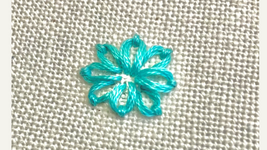

Lazy Daisy (Detached Chain Stitch)
The Lazy Daisy Stitch , also known as the detached chain stitch or single chain stitch, is a fun and easy way to add petal-like shapes to...


Whipped Back Stitch
The Whipped Back Stitch is a great technique for adding texture and detail to your embroidery projects. This stitch combines the...


Fishbone Stitch
The Fishbone Stitch is a fantastic technique for creating smooth, textured fills that resemble the veins of leaves or delicate feathering.


The French Knot
Get knotty with the French Knot! Learn how to master this fun stitch and add texture to your embroidery. Perfect for any project!


The Back Stitch
Learn the back stitch step-by-step and discover tips to master corners, curves, and filling techniques. Elevate your embroidery with this es


Satin Stitch
The Satin Stitch is a classic embroidery technique used to create smooth, solid fills.





